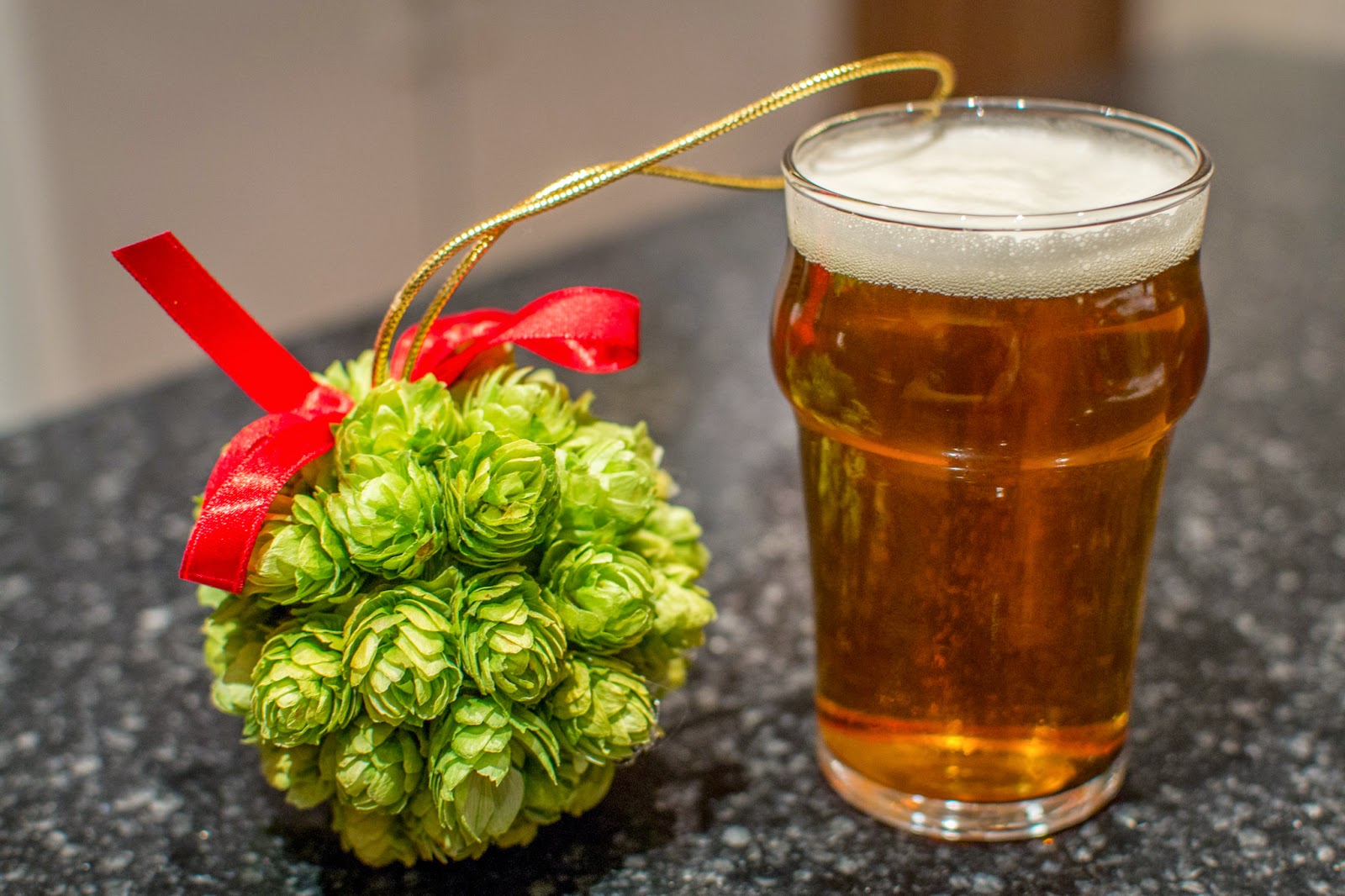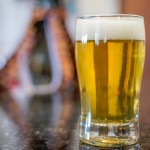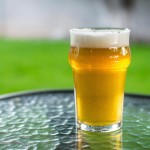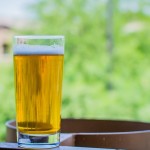Micro Pale Ale 3.0

I’ve been excited to write about this beer for a little while now, as I’ve been trying to craft a session IPA recipe for well over a year. Session IPAs (or whatever you want to call them) are polarizing beers. Personally, I love the concept, as I love a good IPA, but want something I can drink on a weeknight. Those 9% DIPAs take their toll. So I set out to create a really tasty low-gravity IPA, although I didn’t realize quite how hard this style would be to get right.
My first attempt was last May, and while it was a decent start at the style, it was far from great. The beer was dry, lacked any form of body, had no malt character, and came across way too bitter. The aroma was great, but that was about the only thing I got right with that beer. I quickly realized that I really needed to crank up the specialty malts in efforts to give this beer some much needed body.
Roughly 5-6 months later I brewed my second stab at this style. I added an entire pound of C20 and 8oz of Carapils, but kept the mash temp around the same range, thinking 1.5lbs of dextrinous malts would be plenty. It wasn’t. The beer still finished way too low (1.008), and lacked the body I was looking for. So against everything I know about brewing IPAs, I threw more specialty malts at this beer, and mashed it higher yet.
That brings us pretty close to the current batch. This summer I got back to work on this recipe, and finally found something that worked. I decided to bump up the gravity some, throw more dextrine at the beer, add some rye, and bring the mash temp up to 160. I figured I might over do it, but after two tries, I’d rather be on the high-side than the low-side this time. As it were, this batch turned out fantastic. So much so, that I rebrewed nearly the same recipe here, with just a couple hop tweaks.
For this batch I decided to play around with Equinox some, and peppered it in where I could. I’ve bought about a half pound of it over the past year, and I really like the hop so far. Other than that, the hop schedule is pretty similar to the recipe from earlier this summer. The grain bill is also the same, as it’s pretty close to where it needs to be.
The brew days are starting to become really nice here in AZ. This one was a bit more involved, as a storm decided to roll in. I brew under a covered patio, but wind and rain always make things interesting. Despite that, things went reasonably well, especially compared to my recent batch of Pumpkin Porter (stuck sparge). I mashed for 60 minutes, boiled for 60, and whirlpooled the flameout hops for 15 minutes before I began to chill the wort. The gravity came in a couple points high, but nothing I was going to lose any sleep over. I oxygenated the wort, and pitched a small starter of WLP090 before buttoning everything up in the fermentation fridge. I fermented this at 64F for the first few days before ramping it up to 68 when fermentation slowed down.
I dry hopped this directly in the primary while there was still some yeast activity. I’m starting to find that minimizing oxidation outweighs hop/yeast contact. This is pretty much the reverse from what my mindset was a couple years ago. For my IPAs and DIPAs, I still rack the beer into a keg to dry hop, but for low gravity IPAs and Pale Ales, I’m dry hopping in the primary to take advantage of the oxygen-scavenging properties of active yeast. Anyway, the dry hops went in day 6, and I chilled the primary and kegged the beer on day 13.
Brewed: 10-19-14
Kegged: 11-01-14
OG: 1.045
FG: 1.014
ABV: 4.1%
IBU: 40
6 Gallons
6.5lbs 2-row
1lb Munich
1lb Carastan
1lb Carapils
10oz Rye
Mash @ 160*
14g Apollo @ 60
1oz Centennial @ 15
1oz ea Citra/Mosaic + 0.5oz Equinox @ 0
WLP090 – Super San Diego Yeast
Dry Hop: 0.5oz ea Citra/Mosaic/Centennial/Equinox + 0.25oz CTZ
I dropped this beer in my spare keezer, and allowed it to carb up while I waited for space to open up in my main kegerator. I want to say it was in there untouched for about two weeks before I finally cracked into it.
I’ll lead off by saying I’m really happy with how this beer turned out. The malt bill could still use a little bit of tweaking, but it’s leaps and bounds better than the others I’ve brewed before. The appearance is a sparkling clear yellowy-orange; there’s no avoiding a bit of the orange color with a pound of carastan in a 1.045 beer. The fluffy white head lasts for days and days, which I attribute to the rye. The aroma is super fruity with some citrus mixed in as well. The Citra and Mosaic clearly lead the way, but it’s a pretty complex hop nose. There’s no malt to speak of in the aroma.
The flavor is sweet, fruity hops, with some bready malt character. The malt profile of this beer is night and day different from the last beer; it’s amazing what some dextrines will do. Lots of fruity and citrus hops in the finish, with a nice bitterness that doesn’t linger long. The mouthfeel is probably the biggest difference maker in this beer. It ranks about medium, and is perfectly in line with what you’d expect from a standard gravity IPA.
I’m extremely happy with how this recipe is progressing, and how this beer turned out. It drinks just like an IPA despite the 4.1% ABV. I’d also wager that it can stand toe-to-toe with any of the best commercial session IPAs I’ve had. With that said, there’s still some tweaking to do, so where do we go from here? First, with the extra carapils, I can probably back off on the carastan just a touch now. I’m thinking 12-14oz might be just about perfect. The hop profile is good, but I’m not thrilled with the Citra/Mosaic combo. I’m going to replace Mosaic with Amarillo across the board, as I like what the pair of Citra and Amarillo have tasted like in the past. Finally, I think I’ll bump the 2-row up a touch to account for my mistake of gravity. I intended this beer to be a 1.042-1.043 beer, and while I overshot that a bit, it was a happy accident. I’ll likely bump the base malt up just enough so that I can consistently hit 1.045 or so with this beer. As much as I want to make a super-low alcohol beer, sometimes there’s just no replacement for the ethanol.
I’ll likely brew this again sometime shortly after the new year, so stay tuned for the next iteration of the recipe.
Cheers!
PS: Yes, that is a hop mistletoe. My wife found it on Etsy. Pretty cool, huh?




It's great to see you back with such great posts!
Your blog has helped me a lot with hoppier brews, it's a great source of practical information.
I'm about to try something along this lines. It's scorching summer down here in Brazil and I'd love to have a fresh, fruity, lighter IPA on hand.
I'm wondering about flameout and dry hop amounts. Do you feel like it's necessary to compensate for the lower gravity in some way?
Comparing this recipe to your Bertus IPA and your clones, there doesn't seem to be a big difference. Or there is and my mental ounces to grams conversion is throwing me off. Anyway, I'd love to hear your thoughts on that!
Thanks!
It's your mental ounces and grams throwing you off =).
Plus the Bertus IPA is a 12 gallon batch, this beer is a 6 gallon batch.
My IPA has 250g of carastan, and no carapils. (per 6 gallons)
This recipe has 450g of carastan, 450 of carapils, and keep in mind, as a percentage, they are significantly higher.
This beer also is mashed at 71C rather than 66.5C.
As far as hopping goes, I'm really not compensating too much for the lower gravity. You can use a pretty heavy hand with the hops still.
That's great! I didn't really get myself across that well there. I meant differences only in regard to hops, flameout and dry hops more specifically. It seems to me you basically used the same average amount of aroma hops in all those brews I mentioned.
And you just said you don't compensate much, so that's confirmed! =)
I'm going to stick with around the same amounts I use for dry-hopping "standard" IPAs.
Thank you!
Looks good. Thats a big specialty grain bill though. Does the 090 really go that far?
Did you think about using a lower attenuating English type yeast? Might have been worth a shot?
Otherwise it looks great, I've been meaningto brew something sessionable, so it looks like this might be it, although I'll probably bakc off a touch on the spec malts.
Looks good. I've done a couple of Session IPAs myself (both single-hop, one with Mosaic, one with El Dorado), and was planning on doing one again in January with Equinox.
I may have to give your malt bill a shot; I've definitely tried to do the same, where I'm adding more specialty malts and mashing higher than I normally would for a straight IPA or DIPA, but I haven't gone with THAT high of a percentage or mash temp. Worth a shot!
Have you considered using a yeast that leaves an impression of a fuller mouthfeel? I've had success using conan in "session" beers as it leaves a thicker mouthfeel than the FG would usually indicate. It doesn't hurt that conan's esters closely resemble hop flavors either!
Scott, great writing. This really is the most well written and thoughtful home brewing blog out there. I appreciate your attention to detail, reproducibility, and the scientific bent. Too many home brewers out there that don't keep good notes! Im looking forward to brewing one of your IPAs (now I'm torn between Enjoy By vs a session IPA). Quick question about your water chemistry. Do you shoot for higher sulfates with gypsum? If so, is there an absolute SO4 number you look for? Or a Cl/SO4 ratio?
Ya, you'd be surprised how well 090 and 001 ferment low gravity beers. Keep in mind: pure oxygen, lots of healthy yeast, tightly managed fermentation temps.
It's sounds crazy, but that's what it took to make a drinkable beer for me. You could definitely use an English yeast and adjust with less crystal or a lower mash temp.
Haha, ya, it went against every instinct I have about brewing IPAs. These small beers are tough.
I have, and an English yeast would probably work well. Like many things, there's more than one way to skin a cat.
I stuck with 090 because I know it inside and out. You'll still need a very dextrose heavy wort with a less attenuative yeast though.
Thanks, I really appreciate it. For water profile I'm targeting roughly 100-150ppm calcium and 100-200 sulfates for IPAs. I don't stress over the details too much of water anymore. I find getting in the ballpark is plenty good enough.
So I start with RO water, add 2% acid malt to the grist, and dose the water with 1/2tsp calcium chloride and 1-1.5tsp gypsum per 5gal. That's a pretty good IPA profile for me and my water. Keep in mind Phoenix has Jesus Christ water, and even a 90% rejection leaves my water with 40-50 TDS.
I'm really surprised you get acceptable aroma from that hopping rate in the primary. Curious why you don't dry hop this in the keg like your regular IPAs? And do you still use the stainless dry hopper?
Ya, I tried this out of laziness and for giggles. I knew Sierra and Firestone dry hop while they still have yeast activity, so I figured what the hell. A few years ago I kind of treated oxidation in IPAs as a bogeyman that wasn't real, and I'm finding it to be much more critical than yeast-hop contact. I remember listening to pro brewers talk about flushing everything with CO2 like it was the most important thing, and kind of shrugging it off. And I'd have to say I felt like I was in the majority when I thought that. Group think in the homebrewing community was that oxidation really wasn't a big deal for homebrewers.
I guess for me it's one of those things where one train of thought transforms into another, and then into another, and you kind of forget where you started.
You bring up a rather good point though, one that homebrewers often CRITICALLY overlook: the process can be just as critical as the recipe. Most likely, I could dry hop this beer in a CO2-purged keg with less hops, and get similar flavor and aroma. To me, the cost of an extra ounce of hops is worth the time-savings of having to clean, sanitize, and rack to an extra vessel. For beers like this I can get away with it. For DIPAs, i can't get the aroma I want without dry hopping in a keg.
I guess see what works for you and roll with it.
I hear you. I've definitely oxidized IPAs, especially when I used to crash in the primary. I recently switched over to dry yeast because I'm lazy, but US-05 doesn't floc very well. Seriously considering going back to 007. I bet your process would work even better with that yeast, as so much of it will drop like a brick by the time you dry hop. Best of both worlds, sorta?
Nice, cheers. Yeah I'm a big fans of yeasts like WYeast 1469, so I figured it'd work well with a hoppy beer ,as it'll leave enough behind to make life interesting. It can be quite an estery strain, so I like to pitch nice and low and let it rise to the standard ferm temp. then manage from there.
Top blog by the way, If your bored check mine out:
http://www.beercrusades.blogspot.com
Sorry to come back with another question – as well as looking for a good sub for the equinox (which uk suppliers don't seem to have at the moment), I was also planning on subbing some of the centennial with something like columbus (if I can't get enough centennial). Malt wise, I've come across cara munich II – do you have any idea whether this is the same as/a good enough substitute for carastan? Thanks for any replies – still pretty much starting out with home brewing but your blog is a massive help! Cheers
trying to wrap my head around the oxidation thing. i don't think i need to pre-flush my primary better bottle with co2 as adding the yeast should blow off any o2 inside it. and i dryhop/secondary in my keg like you do. it would seem to me that the co2 present in the primary should protect the small surface area when filling the keg. and i flush the keg after it's full with co2 a few minutes later when i get it hooked up to gas. i just can't believe that you could oxidize 5 gallons with a very small surface area exposed to a small amount of oxygen in under 5 minutes? am i wrong here? i realize big brewers take extra precautions but they are also dealing with much larger volumes of beer and o2?
i guess what i'm trying to confusingly say is that the only part that seems like it might be necessary at all is just flushing/purging the headspace in your keg after filling it with co2 a few times?
Those subs should work just fine. Anything citrusy will make a decent replacement. Carastan is a Light English Crystal. You're looking for something in the 30-40L range. It's often called caramalt.
Correct, you definitely don't need to purge your primary prior to filling. The yeast can actually use the O2 in the initial phases of fermentation. I wouldn't worry too much about the primary while you are racking to the keg; worry more about the keg, and flushing it prior to filling.
You're not going to oxidize beer in just 5 minutes, but think about it this way, when you rack a beer, every drop of the beer is getting transferred through your racking line. If the vessel it's going into has O2, you're getting lots of oxygen contact.
Try it yourself. If you your beers have better hop aroma, you'll know if it's worth your time.
For highly hopped IPAs, I would strongly suggest also purging the keg prior to filling.
Thanks Scott – found light crystal here which should do nicely. Any thoughts on mosaic as a sub for equinox? Or maybe galaxy? Unfortunately my LHBS isn't stocking equinox yet. Thanks again
Great information, Scott! Your brewing processes and write-ups have changed my brewing knowledge and abilities greatly! PS did you make or purchase the mistletoe-hopball ornament in the picture? Cheers!
(By the way I suggested mosaic in place of equinox as I'm putting Amarillo in as you mention in your post). Also, what would your final amount of 2 row be to hit 1.045? Thanks
Thanks! We purchased the hop mistletoe on Etsy. I'd love to take credit for it, but that wasn't me =)
Scott, I've brewed what I think is a great session IPA without using much crystal malts (disclosure: I don't care for crystal in my IPAs). First, I use Maris Otter as my base malt, which comes off a little more "bready" than american 2-row. Secondly, I use about 6-8% red wheat malt in the grist, which increases perceived body while not adding much in the way of additional complex sugars, really improves head retention, and keeps the beer pale (5-7 SRM).
Tx for the session recipe insight. I'm mashing thus in with suggested adjustments in 2 weeks. I'm thinking of substituting super with cal ale liquid. Any issues you rekon?
I'm very new to home brewing but I subbed super for Cali ale yeast and the FG only reached 1.018 instead of 1.014. I was actually going to ask Scott whether this would be down to temperature and (perhaps) the yeast stalling, or whether it's just the yeast's performance? Thanks
HI Chris, I thought cal ale might not go down that far. You used a starter?
I might have to shell out for $10 postage for the super 090. Or finish it off a mug of WY3711 that I have in the fridge. But 3711 might go too far as always.
Or I could mash lower.
(Ponder)
Hey, I actually re-brewed this with San Diego super and it started out at 1.054, then added water post boil to bring it down to 1.045, but after fermentation it was still only 1.018 – works out at 3.6%!
I didn't use a starter at all, just pitched straight from the tube (liquid yeast). Fermentation with the 090 looked really active and was cleared up very quickly, so I'm not sure why it finished as high as it did?
Thanks for the heads up Chris.
Im pitching the 090 with starter in this recipe in a few days. Might mash a tad lower. Maybe 68.
1.018 twice in a row for you… thats got body! Maybe get some dry beer enzyme to convert more dextrines; but careful with that stuff!
Mashing lower means you get more sugars from the malt then? Afraid I'm still a bit of a noob. When you say it's got body – I was thinking it would actually work out thinner as it's lower abv – but is that not the case?
Also looking for guidance on making up a starter from a tube of 090, although I only have one tube so have to make sure I get it right! Any suggestions where to look for a good instruction video? Cheers again!
Chris Moss, I won't get into enzymes (see How to Brew by Palmer), but mashing lower (~145-149°F) produces a beer that is more fermentable, and will finish drier (lower FG), and perceived body will be less (all other things being equal). Mashing higher (~150-158°F) will produce a beer that is less fermentable, will finish with a higher FG, and will have increased perceived body. Seriously thought, get Palmers book.
Hey Michael – thanks for that – I've been reading bits of Palmer's book online but admittedly (as anyone here will spot) haven't read all that much as yet. Cheers again
+2 Micheal and +2 Palmers book.
https://www.youtube.com/watch?v=1PSvCRtVdZU
https://www.youtube.com/watch?v=1zUYxb-_B8A
Just thought Chris… Your mash Ph… If that was off, that could have given you the low fg.
You check it?
I have to say I don't know my mash ph, however I've made other beers with our tap water that have been fine. Actually the FG turned out at 1.016 so not too far off.
Can I ask – has anyone brewed this and found it overly bitter? I've just tried mine which has been in bottles for 3 weeks and it's unpleasantly bitter, more so than it should be at 3 weeks I think. I think I've had this before in another brew and wondered whether I'm making some kind of mistake with the hop schedule (although I followed it to the letter) to have this effect. I'm pretty sure it's the hopping as I made a saison with very little hops and it was great!
Well, I finally cloned that recipe last weekend. Hit all the numbers. First time with the WPL090.
Got a bit scared by Chris's experience of under attenuation and went for a 69 C mash (156F)
Day 4 now. Ive hit 1.012.. So maybe recipe was spot on. 🙁
Great flavours with that hop combo!
FG 1.010 ! Mashed at 69 degrees C (156F) . Recipe is probably spot on… Sorry Chris.
Just wanted to let you know I brewed this, and it came out fantastic. The malt profile is really nice and something that I will use again. Thanks for the great recipe. Better then most commercial session ipas.
I am considering brewing this beer and I am having some trouble squaring the estimated IBU's given and that I am calculating with the given hop schedule. My guess is the grey area is the IBU contribution from the whirlpool/hop stand hops. I don't believe that these hops will contribute 0 IBU. It also appears that all the recipe IBU would be provided from the Apollo/Centennial hops. Even only using a 5% utilization % for the whirlpool hops, the estimated IBUs are above 60. Should one really be targeting 40 IBUs or are there actually more IBUs in this hop schedule? Thanks for sharing your thoughts.
Just kegged a batch of this and it is FANTASTIC. I followed Scott's recommended adjustments with 12oz of Carastan and Amarillo instead of Mosaic. Pronounced grapefruit aroma and a smooth and very hoppy finish. Probably the best beer I've brewed to date. Can't wait to share it and get some feedback.